�
INTRODUCTION TO
STOCHASTIC CALCULUS
WITH APPLICATIONS
SECOND EDITION
This page intentionally left blank
�
Fima C Klebaner
Monash University, Australia
Imperial College Press
�
Published by
Imperial College Press
57 Shelton Street
Covent Garden
London WC2H 9HE
Distributed by
World Scientific Publishing Co. Pte. Ltd.
5 Toh Tuck Link, Singapore 596224
USA office: 27 Warren Street, Suite 401-402, Hackensack, NJ 07601
UK office: 57 Shelton Street, Covent Garden, London WC2H 9HE
British Library Cataloguing-in-Publication Data
A catalogue record for this book is available from the British Library.
INTRODUCTION TO STOCHASTIC CALCULUS WITH APPLICATIONS
(Second Edition)
Copyright © 2005 by Imperial College Press
All rights reserved. This book, or parts thereof, may not be reproduced in any form or by any means,
electronic or mechanical, including photocopying, recording or any information storage and retrieval
system now known or to be invented, without written permission from the Publisher.
For photocopying of material in this volume, please pay a copying fee through the Copyright
Clearance Center, Inc., 222 Rosewood Drive, Danvers, MA 01923, USA. In this case permission to
photocopy is not required from the publisher.
ISBN 1-86094-555-4
ISBN 1-86094-566-X (pbk)
Printed in Singapore.
�
Preface
Preface to the Second Edition
The second edition is revised, expanded and enhanced. This is now a more
complete text in Stochastic Calculus, from both a theoretical and an appli-
cations point of view. Changes came about, as a result of using this book
for teaching courses in Stochastic Calculus and Financial Mathematics over a
number of years. Many topics are expanded with more worked out examples
and exercises. Solutions to selected exercises are included. A new chapter
on bonds and interest rates contains derivations of the main pricing mod-
els, including currently used market models (BGM). The change of numeraire
technique is demonstrated on interest rate, currency and exotic options. The
presentation of Applications in Finance is now more comprehensive and self-
contained. The models in Biology introduced in the new edition include the
age-dependent branching process and a stochastic model for competition of
species. These Markov processes are treated by Stochastic Calculus tech-
niques using some new representations, such as a relation between Poisson
and Birth-Death processes. The mathematical theory of filtering is based on
the methods of Stochastic Calculus. In the new edition, we derive stochastic
equations for a non-linear filter first and obtain the Kalman-Bucy filter as a
corollary. Models arising in applications are treated rigorously demonstrating
how to apply theoretical results to particular models. This approach might
not make certain places easy reading, however, by using this book, the reader
will accomplish a working knowledge of Stochastic Calculus.
Preface to the First Edition
This book aims at providing a concise presentation of Stochastic Calculus with
some of its applications in Finance, Engineering and Science.
During the past twenty years, there has been an increasing demand for tools
and methods of Stochastic Calculus in various disciplines. One of the greatest
demands has come from the growing area of Mathematical Finance, where
Stochastic Calculus is used for pricing and hedging of financial derivatives,
v
�
vi
PREFACE
such as options. In Engineering, Stochastic Calculus is used in filtering and
control theory.
In Physics, Stochastic Calculus is used to study the effects
of random excitations on various physical phenomena. In Biology, Stochastic
Calculus is used to model the effects of stochastic variability in reproduction
and environment on populations.
From an applied perspective, Stochastic Calculus can be loosely described
as a field of Mathematics, that is concerned with infinitesimal calculus on non-
differentiable functions. The need for this calculus comes from the necessity to
include unpredictable factors into modelling. This is where probability comes
in and the result is a calculus for random functions or stochastic processes.
This is a mathematical text, that builds on theory of functions and prob-
ability and develops the martingale theory, which is highly technical. This
text is aimed at gradually taking the reader from a fairly low technical level
to a sophisticated one. This is achieved by making use of many solved exam-
ples. Every effort has been made to keep presentation as simple as possible,
while mathematically rigorous. Simple proofs are presented, but more techni-
cal proofs are left out and replaced by heuristic arguments with references to
other more complete texts. This allows the reader to arrive at advanced results
sooner. These results are required in applications. For example, the change
of measure technique is needed in options pricing; calculations of conditional
expectations with respect to a new filtration is needed in filtering. It turns out
that completely unrelated applied problems have their solutions rooted in the
same mathematical result. For example, the problem of pricing an option and
the problem of optimal filtering of a noisy signal, both rely on the martingale
representation property of Brownian motion.
This text presumes less initial knowledge than most texts on the subject
(M´etivier (1982), Dellacherie and Meyer (1982), Protter (1992), Liptser and
Shiryayev (1989), Jacod and Shiryayev (1987), Karatzas and Shreve (1988),
Stroock and Varadhan (1979), Revuz and Yor (1991), Rogers and Williams
(1990)), however it still presents a fairly complete and mathematically rigorous
treatment of Stochastic Calculus for both continuous processes and processes
with jumps.
A brief description of the contents follows (for more details see the Table
of Contents). The first two chapters describe the basic results in Calculus and
Probability needed for further development. These chapters have examples but
no exercises. Some more technical results in these chapters may be skipped
and referred to later when needed.
In Chapter 3, the two main stochastic processes used in Stochastic Calculus
are given: Brownian motion (for calculus of continuous processes) and Poisson
process (for calculus of processes with jumps).
Integration with respect to
Brownian motion and closely related processes (Itˆo processes) is introduced
in Chapter 4. It allows one to define a stochastic differential equation. Such
�
PREFACE
vii
equations arise in applications when random noise is introduced into ordinary
differential equations. Stochastic differential equations are treated in Chapter
5. Diffusion processes arise as solutions to stochastic differential equations,
they are presented in Chapter 6. As the name suggests, diffusions describe a
real physical phenomenon, and are met in many real life applications. Chapter
7 contains information about martingales, examples of which are provided by
Itˆo processes and compensated Poisson processes, introduced in earlier chap-
ters. The martingale theory provides the main tools of stochastic calculus.
These include optional stopping, localization and martingale representations.
These are abstract concepts, but they arise in applied problems, where their
use is demonstrated. Chapter 8 gives a brief account of calculus for most
general processes, called semimartingales. Basic results include Itˆo’s formula
and stochastic exponential. The reader has already met these concepts in
Brownian motion calculus given in Chapter 4. Chapter 9 treats Pure Jump
processes, where they are analyzed by using compensators. The change of
measure is given in Chapter 10. This topic is important in options pric-
ing, and for inference for stochastic processes. Chapters 11-14 are devoted
to applications of Stochastic Calculus. Applications in Finance are given in
Chapters 11 and 12, stocks and currency options (Chapter 11); bonds, inter-
est rates and their options (Chapter 12). Applications in Biology are given
in Chapter 13. They include diffusion models, Birth-Death processes, age-
dependent (Bellman-Harris) branching processes, and a stochastic version of
the Lotka-Volterra model for competition of species. Chapter 14 gives ap-
plications in Engineering and Physics. Equations for a non-linear filter are
derived, and applied to obtain the Kalman-Bucy filter. Random perturba-
tions to two-dimensional differential equations are given as an application in
Physics. Exercises are placed at the end of each chapter.
This text can be used for a variety of courses in Stochastic Calculus and
Financial Mathematics. The application to Finance is extensive enough to
use it for a course in Mathematical Finance and for self study. This text is
suitable for advanced undergraduate students, graduate students as well as
research workers and practioners.
Acknowledgments
Thanks to Robert Liptser and Kais Hamza who provided most valuable com-
ments. Thanks to the Editor Lenore Betts for proofreading the 2nd edition.
The remaining errors are my own. Thanks to my colleagues and students
from universities and banks. Thanks to my family for being supportive and
understanding.
Fima C. Klebaner
Monash University
Melbourne, 2004.
�
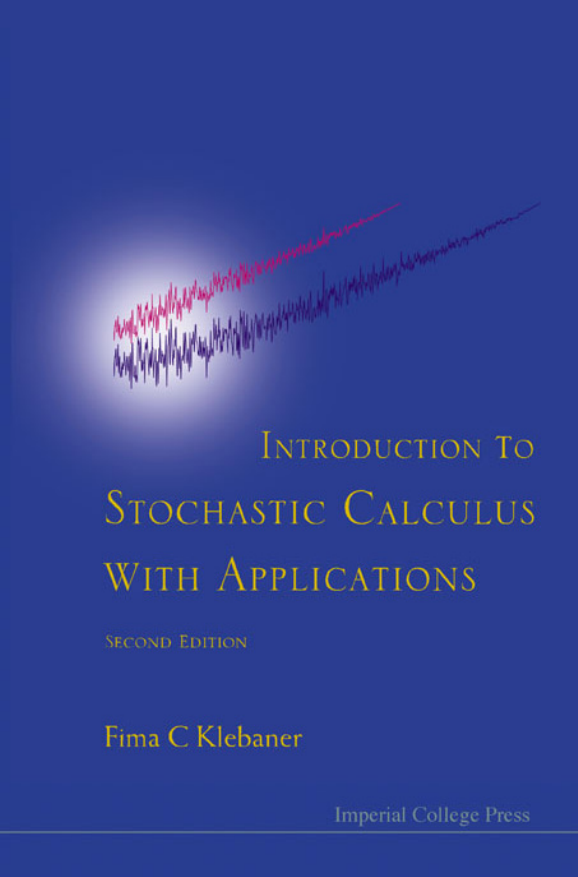
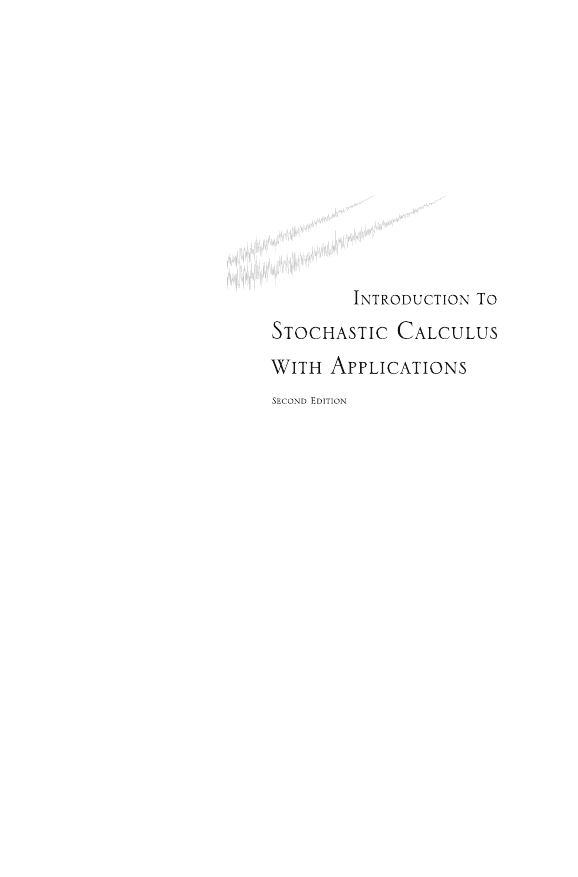

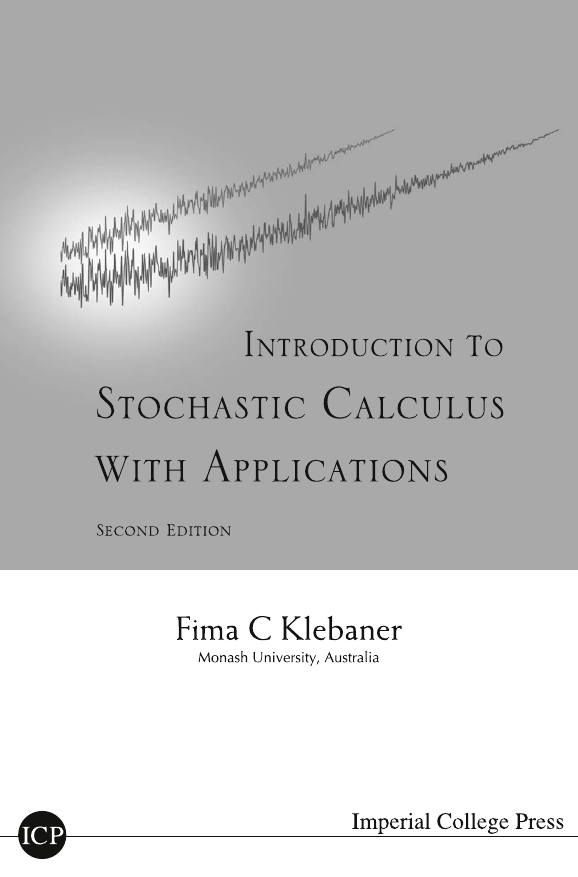
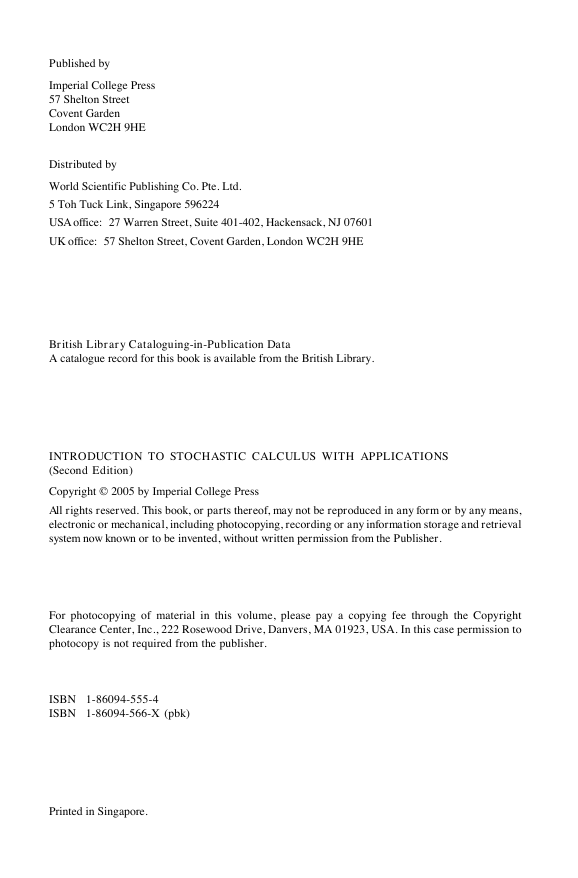
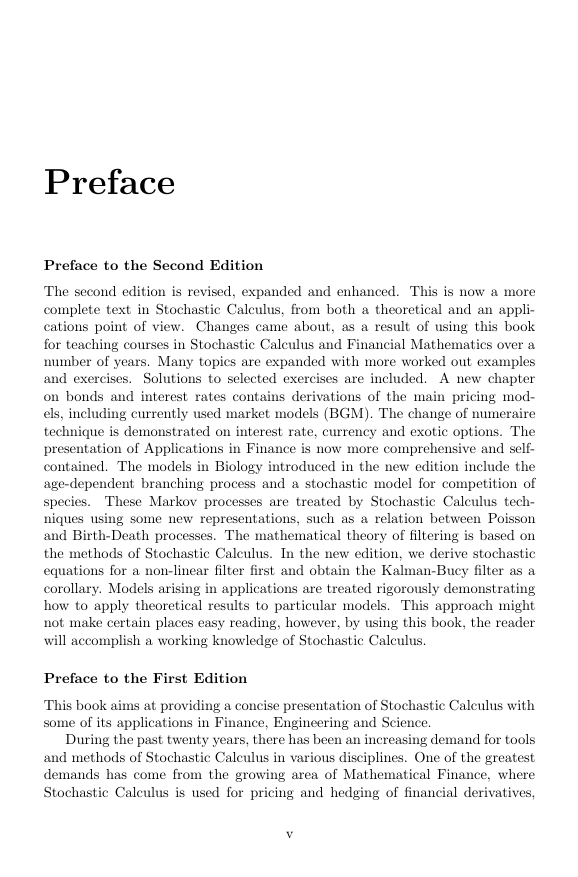
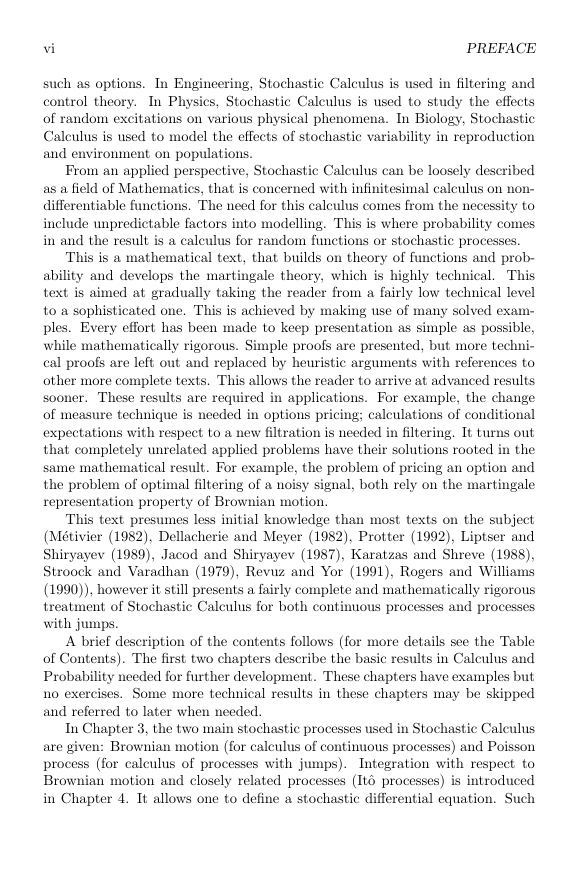
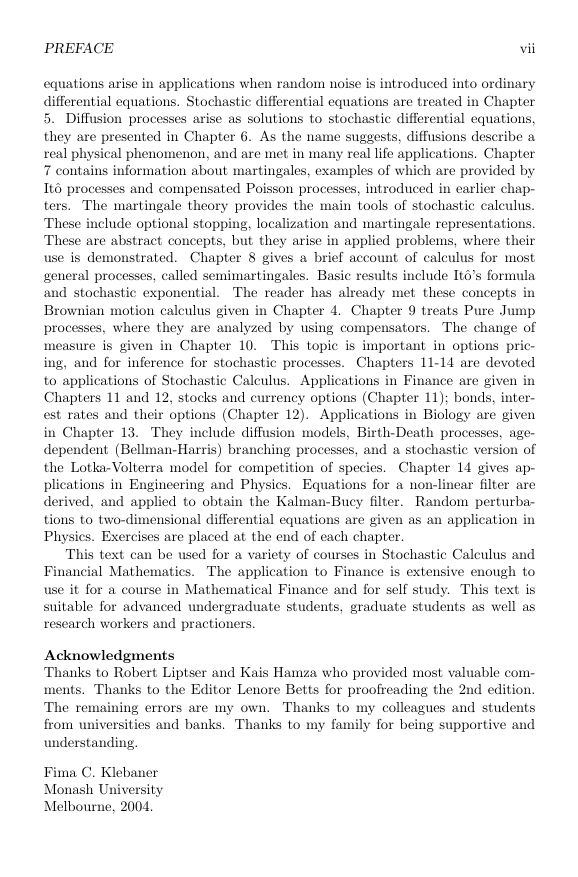








 2023年江西萍乡中考道德与法治真题及答案.doc
2023年江西萍乡中考道德与法治真题及答案.doc 2012年重庆南川中考生物真题及答案.doc
2012年重庆南川中考生物真题及答案.doc 2013年江西师范大学地理学综合及文艺理论基础考研真题.doc
2013年江西师范大学地理学综合及文艺理论基础考研真题.doc 2020年四川甘孜小升初语文真题及答案I卷.doc
2020年四川甘孜小升初语文真题及答案I卷.doc 2020年注册岩土工程师专业基础考试真题及答案.doc
2020年注册岩土工程师专业基础考试真题及答案.doc 2023-2024学年福建省厦门市九年级上学期数学月考试题及答案.doc
2023-2024学年福建省厦门市九年级上学期数学月考试题及答案.doc 2021-2022学年辽宁省沈阳市大东区九年级上学期语文期末试题及答案.doc
2021-2022学年辽宁省沈阳市大东区九年级上学期语文期末试题及答案.doc 2022-2023学年北京东城区初三第一学期物理期末试卷及答案.doc
2022-2023学年北京东城区初三第一学期物理期末试卷及答案.doc 2018上半年江西教师资格初中地理学科知识与教学能力真题及答案.doc
2018上半年江西教师资格初中地理学科知识与教学能力真题及答案.doc 2012年河北国家公务员申论考试真题及答案-省级.doc
2012年河北国家公务员申论考试真题及答案-省级.doc 2020-2021学年江苏省扬州市江都区邵樊片九年级上学期数学第一次质量检测试题及答案.doc
2020-2021学年江苏省扬州市江都区邵樊片九年级上学期数学第一次质量检测试题及答案.doc 2022下半年黑龙江教师资格证中学综合素质真题及答案.doc
2022下半年黑龙江教师资格证中学综合素质真题及答案.doc